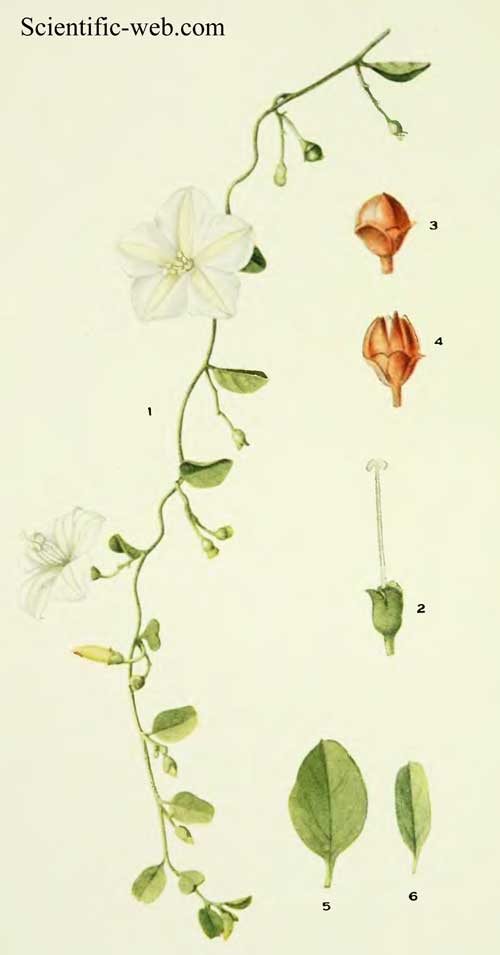
Jacquemontia reclinata
Classification System: APG IV
Superregnum: Eukaryota
Regnum: Plantae
Cladus: Angiosperms
Cladus: Eudicots
Cladus: Core eudicots
Cladus: Asterids
Cladus: Lamiids
Ordo: Solanales
Familia: Convolvulaceae
Tribus: Jacquemontieae
Genus: Jacquemontia
Species: Jacquemontia reclinata
Name
Jacquemontia reclinata House, Bull. New York Bot. Gard. 3: 435 (1905).
Distribution
Native distribution areas:
Continental: Northern America
Regional: Southeastern U.S.A.
Florida.
References: Brummitt, R.K. 2001. TDWG – World Geographical Scheme for Recording Plant Distributions, 2nd Edition
References
Primary references
House, H.D. 1905. Bulletin of the New York Botanical Garden 3: 435.
Links
Govaerts, R. et al. 2019. Jacquemontia reclinata in World Checklist of Selected Plant Families. The Board of Trustees of the Royal Botanic Gardens, Kew. Published on the internet. Accessed: 2019 November 17. Reference page.
Hassler, M. 2019. Jacquemontia reclinata. World Plants: Synonymic Checklists of the Vascular Plants of the World In: Roskovh, Y., Abucay, L., Orrell, T., Nicolson, D., Bailly, N., Kirk, P., Bourgoin, T., DeWalt, R.E., Decock, W., De Wever, A., Nieukerken, E. van, Zarucchi, J. & Penev, L., eds. 2019. Species 2000 & ITIS Catalogue of Life. Published on the internet. Accessed: 2019 November 17. Reference page.
International Plant Names Index. 2019. Jacquemontia reclinata. Published online. Accessed: November 17 2019.
Tropicos.org 2019. Jacquemontia reclinata. Missouri Botanical Garden. Published on the internet. Accessed: 2019 November 17.
USDA, ARS, Germplasm Resources Information Network. Jacquemontia reclinata in the Germplasm Resources Information Network (GRIN), U.S. Department of Agriculture Agricultural Research Service. Accessed: 09-Oct-10.
Vernacular names
English: Beach clustervine
Jacquemontia reclinata is a rare species of flowering plant in the morning glory family known by the common names beach clustervine, reclined clustervine, and beach jacquemontia. It is endemic to the southeastern coast of Florida, mainly within the South Florida metropolitan area, in the United States, where little of its native habitat remains.[2] It is a federally listed endangered species.
This is a creeping vine that has a woody base and stems that grow up to a meter long.[3] The stems may climb on other plants.[2] The vine produces fleshy leaves up to 3 centimeters long[2] and star-shaped white flowers.[4] The plant grows on barrier islands, where it can be found in several types of habitat, such as sand dunes and tropical hardwood hammocks.[4] It grows in sunny open and disturbed areas, bare patches historically created by hurricanes and today sometimes created by human activity.[2] Other plants growing in this type of habitat include seagrape (Coccoloba uvifera) and Madagascar periwinkle (Catharanthus roseus).[2]
In 2001 there were ten known populations of this plant for a total of about 733 individuals.[4] In 2007 it was estimated that the total population had decreased 13% since the year 2000.[5] The species is present in Broward, Palm Beach, and Dade Counties.[3] It was known from Martin County but it is thought to be extirpated there.[3] The coastal strips of these counties are heavily populated and constantly expanding, leading to the consumption of natural habitat for residential, commercial, and other uses.[2] Remaining occurrences of the plant are on land that is fragmented and degraded.[5] It is invaded by introduced plant species such as Brazilian pepper (Schinus terebinthifolius).[2] Recreation and beach erosion threaten the plant.[4]
References
Jacquemontia reclinata was first described and published in Bulletin of the New York Botanical Garden 3(11): 435. 1905. "Jacquemontia reclinata House ex Small". The Plant List; Version 1. (published on the internet). Royal Botanic Gardens, Kew and Missouri Botanical Garden. 2010. Retrieved January 26, 2012.
USFWS. Determination of endangered status for a Florida plant, Jacquemontia reclinata. Federal Register November 24, 1993.
J. reclinata. The Nature Conservancy.
J. reclinata. Archived 2010-12-15 at the Wayback Machine Center for Plant Conservation.
USFWS. J. reclinata Five-year Review. May 2007.
External links
USDA Plants Profile
Retrieved from "http://en.wikipedia.org/"
All text is available under the terms of the GNU Free Documentation License

